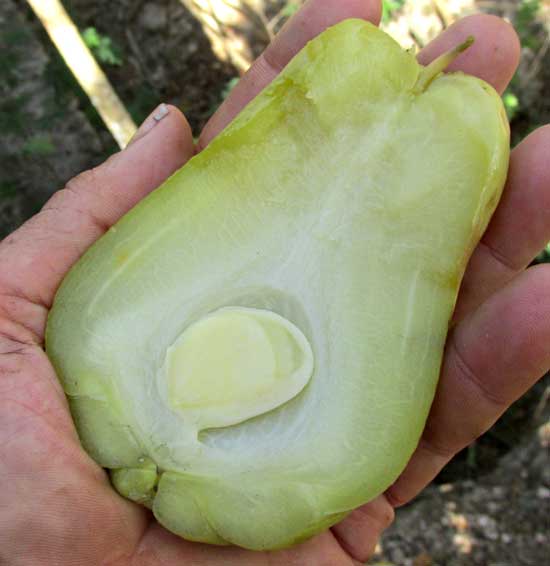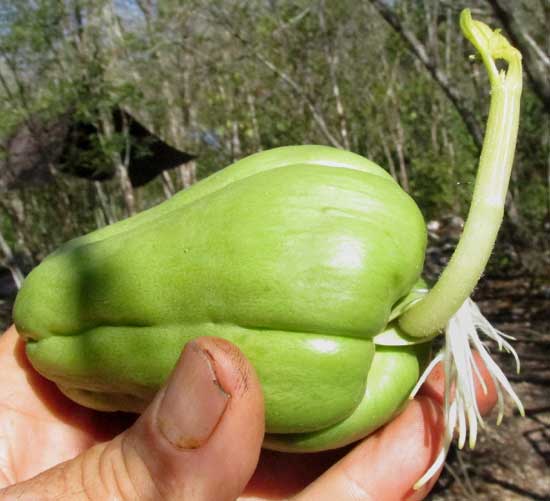Excerpts from Jim Conrad's
Naturalist Newsletter
from the March 5, 2017 Newsletter issued from Rancho Regenesis in the woods ±4kms west of Ek Balam Ruins; elevation ~40m (~130 ft), N20.876°, W88.170°; north-central Yucatán, MÉXICO
EATING CHAYOTE
The Chayote vine, SECHIUM EDULE, is a member of the Squash/Pumpkin/Cucumber Family, the Cucurbitaceae, and a native of Tropical America. Among traditional Mesoamerican indigenous groups, it squash-type fruits are an important food. Back in 2010 a Maya farmer showed us how to plant Chayote squash {next entry}.
This week Jea the Canadian volunteer gardener bought some Chayote to eat, one of which is shown below:

She sliced her raw Chayote into a salad with cabbage and other raw ingredients. I prefer eating them the Maya way, which is to cook them until they're so soft that they practically melt in the mouth. Below, a cut-open one that was cooked for about 15 minutes is shown:

The white, oval item at the bottom is the seed, and for me that's the most tasty part.
from the March 19, 2017 Newsletter issued from Rancho Regenesis in the woods ±4kms west of Ek Balam Ruins; elevation ~40m (~130 ft), N20.876°, W88.170°; north-central Yucatán, MÉXICO
PLANTING CHAYOTE
Some Chayote fruits written about earlier remained uneaten in their crate so long that they began to issue roots and sprouts, as shown below:

In that picture the ascending, green stem is the future vine, the "epicotyl," while the descending white items are roots. Both epicotyl and roots are issuing from between the "lips" of the "tongue" the young gardener had planted facing skyward. That being the case, the protruding "lips" are the tops of the plant's two first leaves, the cotyledons, so the "tongue" is just the two cotyledon tips pressed together.
When seeds of certain species germinate, such as those of the common garden bean, the two cotyledons are pulled from the seed coat and carried above-ground atop the elongating stem, or hypocotyl. This is called "epigeal germination." In other seeds, such as peas, the cotyledons remain within the seed coat while the embryonic stem, or "epicotyl," rises above-ground. This is called "hypogeal germination." On our germinating Chayote fruit the cotyledons clearly are staying in place below-ground, so Chayote fruits practice hypogeal germination.
Therefore, I planted my chayote fruits on their sides just below the soil's surface, so that the soil's moisture would encourage root growth. After just a couple of days most stems already had issued from the soil. Below you can see an inch-tall sprout (2.5cm) with the vine's first leaves preparing to unfurl:
